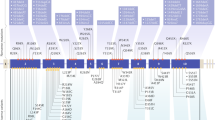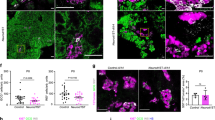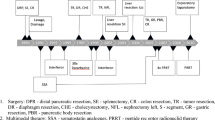Abstract
We report an unusual presentation of multiple endocrine neoplasia type 1 (MEN 1) in a young woman who was subsequently proven to have a novel mutation of the MEN1 gene. The young patient, aged 25 years, was investigated for abdominal discomfort and left upper abdominal pain. Her family history was unremarkable, except an unknown disorder of her father causing early death. Abdominal ultrasonography (USG) and computed tomography revealed a giant pancreatic tumor measuring 10 cm in diameter. The diagnosis of a clinically nonfunctioning pancreatic neuroendocrine tumor was established by clinical and other studies, including USG-guided aspiration biopsy and octreotide scintigraphy, and the patient underwent a distal pancreatectomy. Histology proved a well-differentiated multinodular neuroendocrine tumor of the pancreas. During surgery, a subcutaneous lipoma was also removed from the abdominal wall. Two years later, the patient developed primary hyperparathyroidism, and two enlarged parathyroid glands were surgically removed. Magnetic resonance imaging of the pituitary gland was normal. Screening for MEN1 gene mutation by temperature gradient gel electrophoresis revealed heterozygosities in exons 3, 8, and 9, while direct sequencing indicated a novel germline mutation (C354X) resulting in a stop codon in exon 8 and polymorphisms in exon 3 (R171Q) and exon 9 (D418D and L432L). Genetic screening revealed no mutation in living family members. Our unusual case suggests that a multinodular pancreatic neuroendocrine tumor in a young patient may justify screening for MEN 1 syndrome, even in the absence of other endocrinopathy or family history.
Similar content being viewed by others
Log in or create a free account to read this content
Gain free access to this article, as well as selected content from this journal and more on nature.com
or
References
Baudin E, Bidart J-M, Rougier P, Lazar V, Ruffié P, Ropers J, Ducreux M, Troalen F, Sabourin J-C, Comoy E, Lasser P, DeBaere T, Schlumberger M (1999) Screening for multiple endocrine neoplasia type 1 and hormonal production in apparently sporadic neuroendocrine tumors. J Clin Endocrinol Metab 84:69–75
Brandi ML, Gagel RF, Angeli A, Bilezikian JP, Beck-Peccoz P, Bordi C, Conte-Devolx B, Falchetti A, Gheri RG, Libroia A, Lips CJM, Lombardi G, Mannelli M, Pacini F, Ponder BAJ, Raue F, Skogseid B, Tamburrano G, Thakker RV, Thompson NW, Tomasetti P, Tonelli F, Wells SA, Marx SJ (2001) Guidelines for diagnosis and therapy of MEN type 1 and type 2. J Clin Endocrinol Metab 86:5658–5671
Cebrián A, Ruíz-Llorente S, Cascón A, Osorio A, Martínez-Delgado B, Benítez J, Robledo M (2002) A rapid and easy method for multiple endocrine neoplasia type 1 mutation detection using conformational-sensitive gel electrophoresis. J Hum Genet 47:190–195
Chandrasekharappa SC, Guru SC, Manickham P, Olufemi S-E, Collins FS, Emmert-Buck MR, Debelenko LV, Zhuang Z, Lubensky IA, Liotta LA, Crabtree JS, Wang Y, Roe BA, Weisemann J, Boguski MS, Agarwal SK, Kester MB, Kim YS, Heppner C, Dong Q, Spiegel AM, Burns AL, Marx SJ (1997) Positional cloning of the gene for multiple endocrine neoplasia-type 1. Science 276:404–407
Correa P, Lundgren E, Rastad J, Akerström G, Westin G, Carling T (2002) Multiple endocrine neoplasia type 1 polymorphism D418D is associated with sporadic primary hyperparathyroidism. Surgery 132:450–455
Cupisti K, Höppner W, Dotzenrath C, Simon D, Berndt I, Röher HD, Goretzki PE (2000) Lack of MEN1 gene mutations in 27 sporadic insulinomas. Eur J Clin Invest 30:325–329
Darling TN, Skarulis MC, Steinberg SM, Marx SJ, Spiegel AM, Turner M (1997) Multiple facial angiofibromas and collagenomas in patients with multiple endocrine neoplasia type 1. Arch Dermatol 133:853–857
Edström E, Mahlamaki E, Nord B, Kjellman M, Karhu R, Höög A, Goncharov N, Teh BT, Backdahl M, Larsson C (2000) Comparative genomic hybridization reveals frequent losses of chromosomes 1p and 3p in phaeochromocytomas and abdominal paragangliomas, suggesting a common genetic etiology. Am J Path 156:651–659
European Consortium on MEN1 (1997) Identification of the multiple endocrine neoplasia type 1 (MEN1) gene. Hum Mol Gen 6:1177–1183
Glascock M, Carty SE (2002) Multiple endocrine neoplasia type 1: fresh perspective on clinical features and penetrance. Surg Oncol 11:143–150
Görtz B, Roth J, Speel EJM, Krahenmann A, De Krijger RR, Matias-Guiu X, Muletta-Feurer S, Rütmann K, Saremaslani P, Heitz PU, Komminoth P (1999) MEN1 gene mutation analysis of sporadic adrenocortical lesions. Int J Cancer 80:373–379
Guo SS, Sawicki MP (2001) Molecular and genetic mechanisms of tumorigenesis in multiple endocrine neoplasia type-1. Mol Endocrinol 15:1653–1664
Guru SC, Manickam P, Crabtree JS, Olufemi S-E, Agarwal SK, Debelenko LV (1998) Identification and characterization of the multiple endocrine neoplasia type 1 (MEN1) gene. J Int Med 243:433–439
Hoff AO, Cote GJ, Gagel RF (2000) Multiple endocrine neoplasias. Annu Rev Physiol 62:377–411
Kaji H, Canaff L, Lebrun J-J, Goltzman D, Hendy GN (2001) Inactivation of menin, a Smad3-interacting protein, blocks transforming growth factor type beta signalling. PNAS 98:3837–3842
Kataoka H, Otsuka F, Yamauchi T, Kishida M, Takahashi M, Tamiya T, Mimura Y, Ogura T, Makino H (1999) Giant insulinoma in a patient with multiple endocrine neoplasia type I: a case report. Endocr J 46:429–435
Kouvaraki MA, Lee JE, Saphiro SE, Gagel RF, Sherman SI, Sellin RV, Cote GJ, Evans DB (2002) Genotype-phenotype analysis in multiple endocrine neoplasia type 1. Arch Surg 137:641–647
Lairmore TC, Chen VY, DeBenedetti MK, Gillanders WE, Norton JA, Doherty GM (2000) Duodenopancreatic resections in patients with multiple endocrine neoplasia type 1. Ann Surg 231:909–918
Morelli A, Falchetti A, Martineti V Becherini L, Mark M, Friedman E, Brandi ML (2000) MEN1 gene mutation analysis in Italian patients with multiple endocrine neoplasia type 1. Eur J Endocrinol 142:131–137
Pannett AAJ, Thakker RV (1999) Multiple endocrine neoplasia type 1. Endocr Relat Cancer 6:449–473
Park J-H, Kim I-J, Kang HC, Lee S-H, Shin Y, Kim K-H, Lim S-B, Kang S-B, Lee KU, Kim SY, Lee M-S, Lee M-K, Park J-H, Moon S-D, Park J-G (2003) Germline mutations of the MEN1 gene in Korean families with multiple endocrine neoplasia type 1 (MEN1) or MEN1 related disorders. Clin Genet 64:48–53
Poisson A, Zablewska B, Gaudray P (2003) Menin interacting proteins as clues toward the understanding of multiple endocrine neoplasia type 1. Cancer Lett 189:1–10
Sakurai A, Shirahama S, Fujimori M, Katai M, Itakura Y, Kobyashi S, Amano J, Fukushima Y, Hashizume K (1998) Novel MEN1 gene mutations in familial multiple endocrine neoplasia type 1. J Hum Genet 43:199–201
Sato M, Kihara M, Nishitani A, Murao K, Kobayashi S, Miyauchi A, Takahara J (2000) Large and asymptomatic pancreatic islet cell tumor in a patient with multiple endocrine neoplasia type 1. Endocr J 13:263–266
Trump D, Farren B, Wooding C, Pang JT, Besser GM, Buchanan KD, Edwards CR, Heath DA, Jackson CE, Jansen S, Lips K, Monson JP, O’Halloran D, Sampson J, Shalet SM, Wheeler MH, Zink A, Thakker RV (1996) Clinical studies of multiple endocrine neoplasia type 1 (MEN 1) QJM 89:653–669
Yaguchi H, Ohkuras N, Tsukada T, Yamaguchi K (2002) Menin, the multiple endocrine neoplasia type 1 gene product, exhibits GTP-hydrolizing activity in the presence of the tumor metastasis suppressor nm23. J Biol Chem 277:38197–38204
Author information
Authors and Affiliations
Corresponding author
Rights and permissions
About this article
Cite this article
Balogh, K., Patócs, A., Majnik, J. et al. Unusual presentation of multiple endocrine neoplasia type 1 in a young woman with a novel mutation of the MEN1 gene. J Hum Genet 49, 380–386 (2004). https://doi.org/10.1007/s10038-004-0163-2
Received:
Accepted:
Published:
Issue date:
DOI: https://doi.org/10.1007/s10038-004-0163-2



